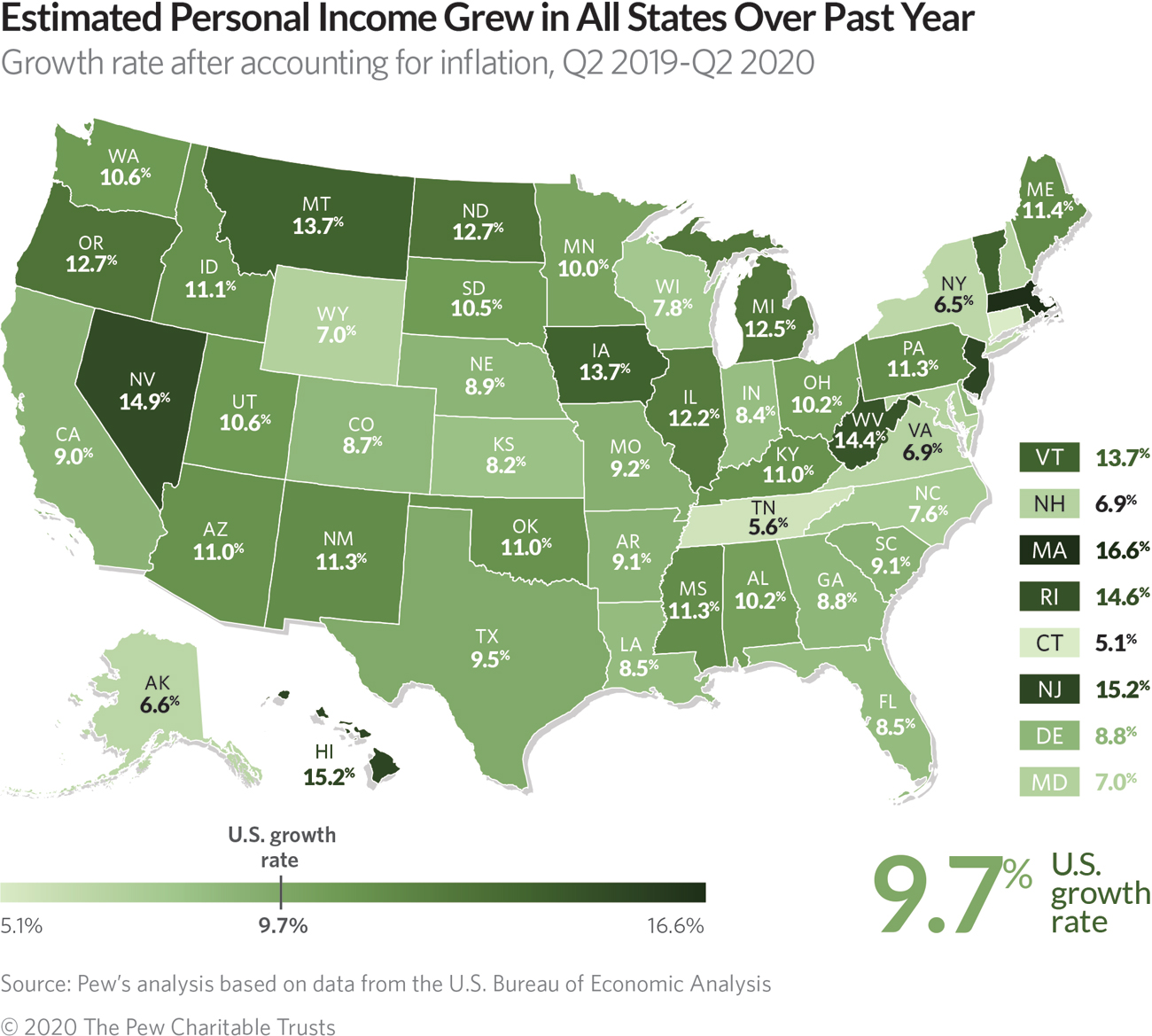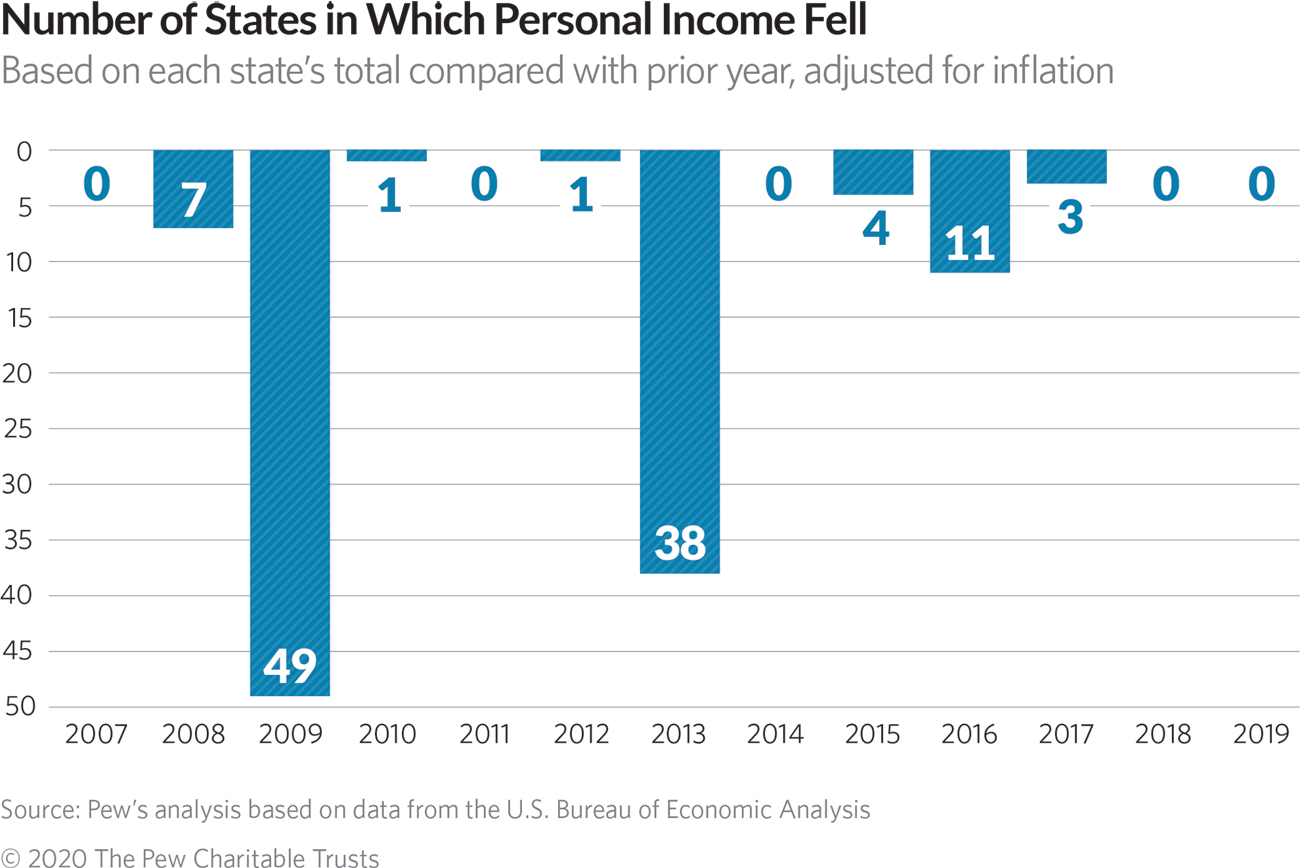Total personal income skyrocketed in every state in the second quarter of 2020, driven by unprecedented support from the government to individuals and businesses facing historic economic distress caused by the COVID-19 pandemic. But the temporary federal assistance obscured the coronavirus’s blow to every state’s economy, as earnings—the bulk of personal income—plummeted.
The spike in government assistance was the main reason that the sum of residents’ personal income soared in every state in the second quarter of 2020, despite a record-setting drop in U.S. economic activity due to the pandemic. The surge in federal assistance more than offset record losses in earnings, which counts wages from work and extra compensation such as employer-sponsored health benefits, as well as business profits.
Earnings nationally fell by roughly $860 billion from the prior quarter and $670 billion from a year ago, based on inflation-adjusted annualized data, representing by far the largest losses on record. The pandemic’s blow to wages and other earnings was far-reaching: Every state, as well as nearly every major industry, suffered a decline as many businesses closed temporarily, workers were laid off, and the national economy—as measured by gross domestic product—contracted. But losses in earnings varied widely across states. Growth rates over the past year ranged from minus 10.1% in Hawaii to minus 0.1% in Utah, driven primarily by losses in the accommodation and food service sector, as tourism and dining dramatically slowed following widespread restrictions on travel and activity, as well as business closures.
Temporary relief programs intended to keep the economy afloat amid the pandemic propelled a major source of personal income: government assistance. Government transfer payments nationwide increased by an annualized $2.47 trillion from 2020’s first quarter and by $2.55 trillion from a year ago, after accounting for inflation. Stimulus payments of up to $1,200 per adult, as well as expanded and more widely distributed unemployment insurance benefits, accounted for roughly $2 trillion of the hike. Growth rates over the past year ranged from 150.9% in Massachusetts to 54.1% in Arkansas. Government assistance payments generally include benefits such as Medicare, Medicaid, Social Security, and Temporary Assistance for Needy Families.
With the additional federal aid offsetting earnings declines, total personal income grew nationally by an annualized $1.8 trillion—equivalent to 9.7%—over the year. Gains ranged from a whopping 16.6% in Massachussetts to 5.1% in Connecticut. However, if government transfers are excluded, personal income nationwide would have fallen by 4.8%, and every state would have recorded a decline. In fact, total personal income would have dropped by more than 5% in nearly half of states.
State personal income —a measure used to assess economic trends—matters to state governments because tax revenue and spending demands may rise or fall along with residents’ incomes. It sums up all the money and benefits that residents receive from work, certain investments, income from owning a business and property, as well as benefits provided by employers or the government, including the extra federal aid provided in response to the COVID-19 pandemic. Results for the second quarter of 2020 are based on estimates and subject to revision, as is Pew’s ranking of growth rates for state personal income.
State highlights over the past year
The second quarter of 2020 reflects the pandemic, business closures, and other effects of the recession that started in February. The estimated compound annual growth rate when each state’s aggregate, inflation-adjusted personal income in the second quarter of 2020 is compared with a year earlier (subject to data revisions) shows:
- Massachusetts (16.6%) recorded the largest growth rate in the sum of all its residents’ personal income of any state, driven by a 150.9% jump in government assistance payments, which was also the highest in the nation.
- Hawaii and New Jersey experienced the next-largest personal income gains after Massachusetts (both 15.2%). In all, 27 states recorded double-digit rate increases. These unprecedented gains resulted from substantial temporary federal aid to individuals and businesses.
- Connecticut (5.1%) and Tennessee (5.6%) registered the slowest personal income growth among states over the past year. Historically, growth rates over 5% would have been among the fastest in any other quarter since the Great Recession.
- In six states, government assistance payments more than doubled from a year ago: Massachusetts (150.9%), New Jersey (146.3%), Hawaii (138.8%), Nevada (122.6%), Illinois (108.5%), and North Dakota (101.5%).
- In terms of earnings, every state recorded a decline compared with the previous year, with drops of more than 5% in 31 states. New York, where much of the initial COVID-19 outbreak in the U.S. was concentrated, recorded the second-largest decline of 9.7% from the prior year, outflanked only by Hawaii, which plunged 10.1% at an annual rate.
- The finance and insurance industry managed to withstand the adverse effects of the downturn better than others. It was partially due to payments that private lenders received from the federal government in the second quarter to administer Paycheck Protection Program loans to small businesses and nonprofits affected by the pandemic. In 30 states, the finance and insurance sector experienced increases in earnings over the year.
States recovered unevenly from the Great Recession
States entered the new recession from vastly different starting points in terms of personal income growth over the longest economic recovery in U.S. history. Inflation-adjusted personal income eventually bounced back in all states, but at different paces. From the start of the Great Recession at the end of 2007 through the fourth quarter of 2019—the last quarter before the coronavirus pandemic started to derail the economy—Utah and North Dakota led all states with long-term compound annual growth rates equivalent to 3.4% and 3.3% a year, respectively, followed by a group of mostly Western states. Connecticut and Mississippi lagged all other states with pre-pandemic growth rates equivalent to 0.9% a year, less than half of the U.S. rate of 2%. These compound annual growth rates represent the pace at which state personal income dollars would need to grow each year to reach their current level, after accounting for inflation.
Alaska and North Dakota were the first states in which total personal income bounced back from its losses, in late 2009, just over two years after the onset of the Great Recession. It wasn’t until the fourth quarter of 2014, seven years after the start of the recession, when the last state—Nevada—recovered. In most states, it took about three years for the aggregate personal income to get back to pre-Great Recession levels, after accounting for inflation.
Although the use of compound annual growth rates allows for comparisons of states’ economic performance over several years, personal income did not actually change at a steady pace, instead falling in some years and rising in others, based on recently revised data.
No state escaped the Great Recession without a calendar-year drop in total personal income, but a handful of states can boast only one decrease, in 2009: Colorado, Idaho, Illinois, Mississippi, Utah, and Washington. The longest recovery on record ended on a high note with every state reporting calendar-year increases in personal income in 2018 and 2019.
What is personal income?
Personal income sums up residents’ paychecks, Social Security benefits, employers’ contributions to retirement plans and health insurance, income from rent and other property, and benefits from public assistance programs such as Medicare and Medicaid, among other items. Personal income excludes realized or unrealized capital gains, such as those from stock market investments.
Federal officials use state personal income to determine how to allocate support to states for certain programs, including funds for Medicaid. State governments use personal income statistics to project tax revenue for budget planning, set spending limits, and estimate the need for public services.
Growth in personal income should not be interpreted solely as wage growth; wages and salaries account for about half of U.S. personal income. Likewise, growth in total state personal income should not be seen as a measure of how much the income of average residents has changed. Other measures should be used to approximate income growth for individuals, such as state personal income per capita or household income.
Looking at state gross domestic product, which measures the value of all goods and services produced within a state, would yield different insights on state economies.
Download the data to see state-by-state growth rates for personal income from 2007 through the second quarter of 2020. Visit Pew’s interactive resource, “Fiscal 50: State Trends and Analysis,” to sort and analyze data for other indicators of state fiscal health.
"assistance" - Google News
November 05, 2020 at 09:14PM
https://ift.tt/36aqgzE
Federal Assistance Boosts States' Personal Income as Economy Falters - The Pew Charitable Trusts
"assistance" - Google News
https://ift.tt/2Ne4zX9
Shoes Man Tutorial
Pos News Update
Meme Update
Korean Entertainment News
Japan News Update
Bagikan Berita Ini

















0 Response to "Federal Assistance Boosts States' Personal Income as Economy Falters - The Pew Charitable Trusts"
Post a Comment